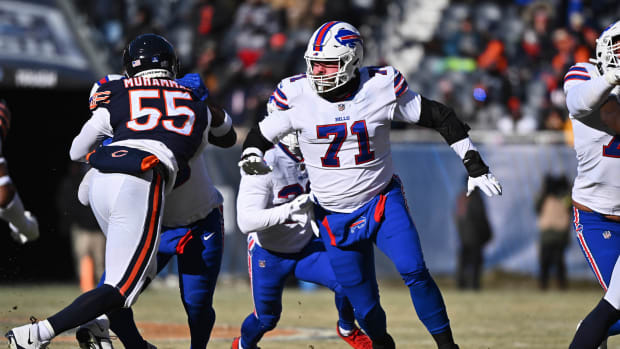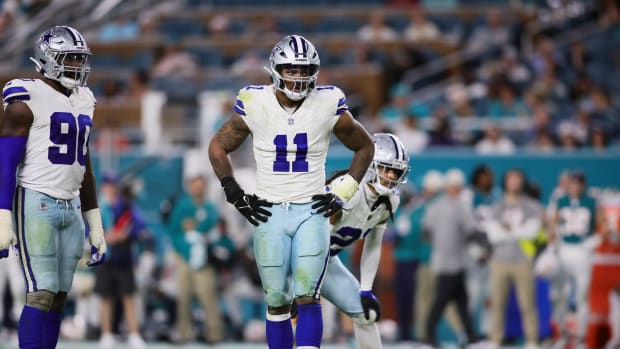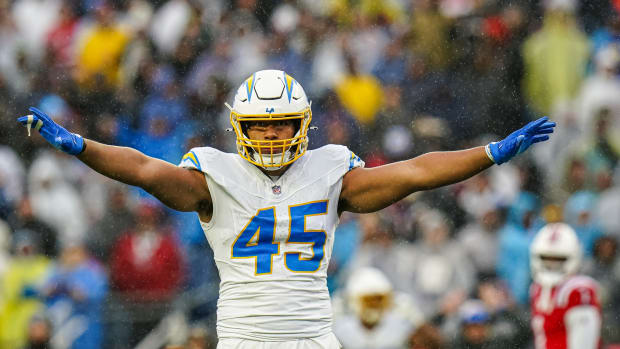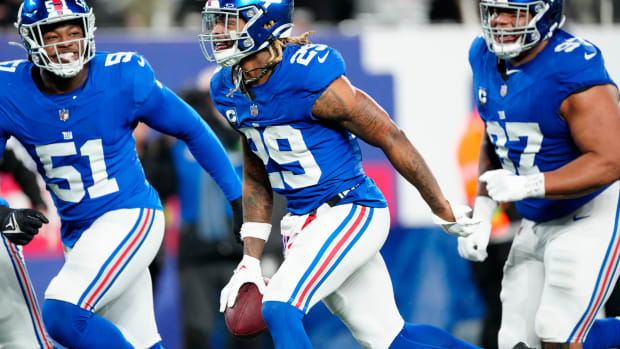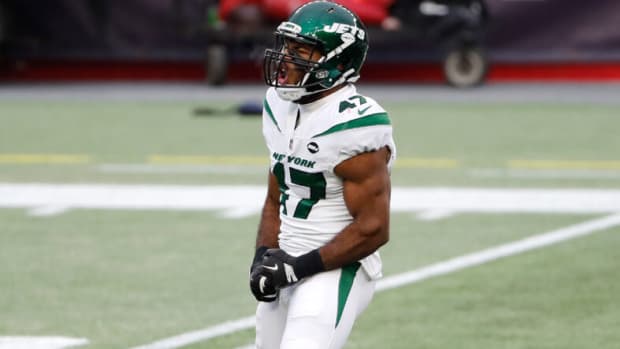Jack Easterby’s Rise to Power and the Chaos That Followed
The film study for one Texans player suddenly required a different kind of source material. In addition to reviewing practice and game tape, he delved into a ruthless fantasy world, seeking insight into the machinations of an extreme power struggle from the television series that tens of millions of others were watching: Game of Thrones.
He wasn’t alone. The grab for the Iron Throne was so analogous to the complicated, real-life dynamics that began to unspool at NRG Stadium last year that it had become something of a reference point among more than a dozen Texans coaches, players and team personnel, who likened the individuals at the top of the organization to characters in the TV drama.
General manager Brian Gaine was Robb Stark, the intended future King of the North, who was murdered by the end of Season 3. (Gaine would be fired after only 17 months as GM.) Coach Bill O’Brien was compared to King Joffrey Baratheon, a hot-headed ruler prone to screaming and chopping off heads, only to be poisoned in Season 4. (O’Brien would be fired in October of this year.)
Then there was Jack Easterby, hired as the franchise’s executive vice president of team development in April 2019, a man who’d risen from low-level Jaguars intern to Patriots team chaplain to lauded character coach—before making an unprecedented shift into football operations. Easterby, those Texans told each other, was Littlefinger, the nickname of Petyr Baelish, a shadowy and cunning operative who on TV espoused righteousness as a strategy, but sought to consolidate power through chaos and isolation and the pulling of strings behind the scenes.
For those who don't watch Game of Thrones, this might be an oblique metaphor, as well as a hyperbolic one. But the point is: A player found insight into his own workplace from a dramaseries about the vicious and unrelenting pursuit of power. “That’s why I was able to read them,” the player says of the trio of decision makers, speaking on the condition of anonymity for fear of retribution. “I knew who it was going to be [at the end].”
Easterby’s sudden ascent to power has generated intense curiosity and, depending on whom you ask, either admiration or scrutiny. He has not conducted any on-the-record interviews since September, leaving others to make sense of perhaps the NFL’s most polarizing executive. In response to interview requests for Easterby and team owner Cal McNair, as well as a list of 83 questions regarding the details of this story, a Texans spokesperson provided broad statements on behalf of McNair and Easterby (which can be read in full here). To Sports Illustrated, some called the 37-year-old a guiding force in their lives, a beloved minister and mentor who shepherded two NFL franchises through difficult times and became part of the foundation of the Patriots’ late-dynasty years, earning him a rare spot in Bill Belichick’s inner circle. Many in Houston, though, have not seen him as the congenial confidant and Belichick foil. Rather, they describe an authority figure whose leadership style sows distrust and division, at times flouting rules and straining relationships inside the building. Meanwhile, his responsibilities expanded despite questions surrounding his credentials.
Conversations with more than 40 people—current and former Texans football operations staff and players, colleagues from Easterby’s time in New England, those from his past in and out of football—provided detailed accounts of his alleged role in, among other things:
- Undermining other executives and decision-makers, including the head coach who helped bring him to Houston.
- The team’s holding workouts at the head strength coach’s house during the COVID-19 pandemic after the NFL had ordered franchises to shut down all facilities, shortly before a breakout of infections among players.
- Advocating for a trade of star receiver DeAndre Hopkins soon after arriving in Houston—one season before Hopkins was sent to Arizona in a widely panned deal.
- Fostering a culture of distrust among staff and players to the point that one Texan and two other staffers believed players were being surveilled outside the building.
When SI began making phone calls in October to make sense of Easterby’s improbable path, he quickly caught wind and reached out to a reporter, saying that he wanted to help communicate “truth and honesty.” Easterby did not return a text message, sent Tuesday, offering a chance to tell his side of the story. But colleagues who spoke to SI—many requesting anonymity, like the player, for fear of retribution—said they felt compelled to share their own truth in the hopes of opening the eyes of McNair, of whom one source said: “[He] is just blinded.” There is a perception inside the Texans’ building that Easterby won a power struggle, completing his climb. And in doing so, these sources say, the character coach brought in to improve the culture has made it worse.
* * *
Whether in front of congregations where the faithful packed into pews, behind the occasional podcast microphone, or standing before a locker room of professional athletes, Easterby likes to tell audiences that the coolest thing about sports is how “everybody has a story.” Easterby often waxed on in a folksy way about his influences, starting with his granddad (also a Jack Easterby), who became a bank treasurer and taught his grandson to take jobs seriously, to not lie and to always write thank-you notes. The younger Easterby also liked to tell audiences how he worked in the mall at a shoe store, emphasizing his humble start.
Easterby’s job in football, he would explain, was to learn the stories of everyone in an organization, come to appreciate their complexity and nuance, then attempt to stitch the stories and people together in a way that made everyone stronger as a whole. It sounded great, much like Easterby’s own story—the one that beckoned more scrutiny with each promotion. Because even Easterby’s allies, those who believe he can command an audience better than most anyone in the NFL, still wonder how he got here.
“It’s still a long-, long-shot story, right?” says one NFL executive who worked directly with Easterby in the past. “You’re not going to be the team chaplain, then, 10 years later, you’re the interim GM. That just doesn’t happen in our league.”
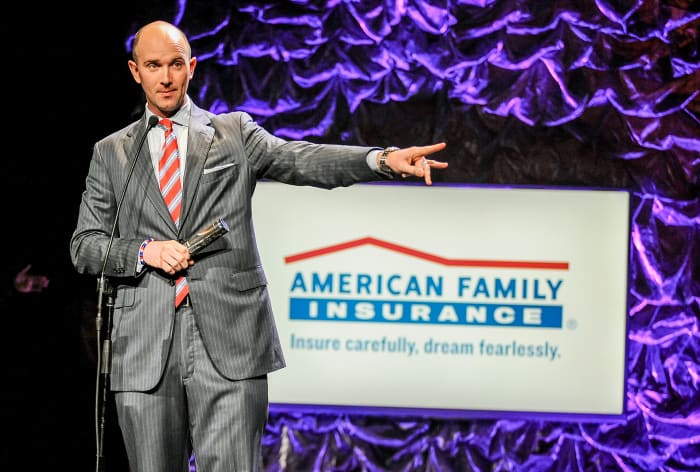
Easterby onstage during the Super Bowl Gospel Celebration in January 2015.
Marcus Ingram/Getty Images/Super Bowl Gospel
That unlikely ascent began on a hot July day back in 2005, on the basketball court. As South Carolina men’s coach Dave Odom made the rounds at his program’s summer camp, he noticed a young counselor who had earned the rapt attention of his campers. When the week concluded the veteran coach would invite Jack Easterby, then a part-time academic tutor at S.C., into his office—and by the fall, Easterby would be a fixture in Odom’s locker room, serving in a new role created by the coach in conjunction with a friend of Easterby’s at the Fellowship of Christian Athletes.
“We gave Jack an opportunity to bring his faith to our team,” Odom says. “We didn’t force him on anyone, but I was amazed at how many of our kids took to him. He was a counselor and a coach—a ‘character coach’ is what we called him.”
Fans couldn’t miss Easterby over the next few seasons, cheering enthusiastically and energetically high-fiving players from the end of the Gamecocks’ bench—an Associated Press beat writer even profiled him in March 2008. Odom, who calls Easterby the “seed” from which today’s character-coach trend began, says he’s surprised at where that young camp counselor ended up 15 years later “only because the NFL is such a closed-door business.”
Easterby was well-liked, even loved, by most at South Carolina. There he earned the ear of Eric Hyman, the Gamecocks’ athletic director from 2005 to ’12. Hyman echoes Odom, saying Easterby was years ahead of the now-pervasive trend toward holistic care and mental health for athletes, acting as an all-around problem-solver. “He was sort of like an ombudsman,” Hyman says. But the unprecedented character coach role sometimes put Easterby’s short-term responsibilities and long-term goals in conflict. He was expected to serve the role of a selfless team chaplain, but he was also a young assistant who understood what he had to do to get ahead: Altruism and ambition don’t always sync. One lower-level athletic department staffer during Easterby’s time at South Carolina put it this way: “When it was just us, he’d want to know how you were doing and wanted to help you in any way he could.” But if an important coach or player walked into the room, “it was like, all of the sudden, you didn’t exist.”
Odom retired in 2008, and the next coach, Darrin Horn, showed little interest in Easterby’s services. After two more seasons under Horn, the program severed ties with the FCA program and the character coach. Easterby stayed in South Carolina, taking a job at his alma mater, Newberry College, as well as continuing to work with S.C. athletes through Gamecocks for Christ, a ministry for the school’s athletes that Easterby had founded. He was active with the women’s basketball program (Dawn Staley, the program’s Hall of Fame coach, raves about Easterby) and worked with players from the football and baseball teams.
Easterby used to pop by Hyman’s office and hand out these little cards bearing wisdom on leadership. Example: a picture of the open road, as seen from a driver’s seat; OUTLOOK splashed across the front; and the relevant lesson—Let your OUTLOOK be primarily focused on what’s in front of you, and let your past experience only serve as a reference—laid out on the back. Or: a picture of an open book; MOVE ON; Don’t dwell on the pages you have already read. Hyman so loved these cards that he kept more than 20 of them.
One year—Hyman thinks this was 2008 or ’09—the AD invited a special guest to talk to the football team. The speaker, a South Carolina alum, spent 10 minutes in that meeting room discussing character and the importance of developing mental skills in addition to physical ones. The Gamecocks’ character coach was sitting near the front of the room, intently focused on the man standing before him: Texans owner Bob McNair.
* * *
Have a tip? Email us.
* * *
It must have been a strange sight: This white brick house in the Houston suburbs, with the neatly landscaped front yard, had a row of oversize vehicles parked in the street out front and some of the city’s best athletes running sprints attached to resistance bands. After all, in spring of 2020 the COVID-19 pandemic was surging. Players lifted together on a covered back patio with squat racks and barbells that had been transported from NRG Stadium, supervised by coaches sporting team apparel; in one video posted to a player’s social media in May, none of the participants were wearing masks.
In March, NFL commissioner Roger Goodell closed all team facilities, and the league and the players union later agreed to conduct all offseason programs virtually, with no in-person interaction except for players who had ongoing medical rehab, based on guidance from medical experts. But in the weeks that followed, small groups of Texans players cycled through the home of head strength and conditioning coach Mike Eubanks, according to four people with direct knowledge of these workouts. Three of these people believe these workouts could not have happened without the approval of Easterby, who oversees the strength and conditioning department.
These sessions, even to Texans employees, appeared to at least violate the purpose of the league’s offseason COVID-19 restrictions, which were implemented to prevent teams from congregating as cases of the highly contagious virus soared nationwide. (An NFL spokesman declined comment.) Eubanks was put in a compromising position professionally; he also had his health, as well as that of the players, their families and their friends, put at risk. (The Texans did not make Eubanks available for an interview.)
The group training continued for several weeks, until early June, when numerous Texans players tested positive for COVID-19 and the team shut down the workouts in response, these sources said. The league was not conducting contact tracing at the time, and it’s impossible to discern exactly how many positive tests resulted from these workouts, but there was concern among the Texans that these team-sanctioned gatherings had played a role in spreading the virus. (Around the time of this outbreak, some of the players who took part in these workouts also attended the funeral for George Floyd, the former Houston resident killed by police in Minneapolis, alongside a larger contingent from the organization, requiring more people to get tested and quarantine.) During this part of the NFL calendar, teams did not have to report positive tests to the league or place players on the COVID-19 list; these cases were not publicly disclosed.
The promotion Easterby received in January, to executive vice president of football operations, reflected the wide-ranging authority he’d gained since being hired nine months earlier. The Texans’ football operations were divided into what they called “subprograms.” O’Brien handled coaching and had final say on the roster. In addition to strength and conditioning, Easterby oversaw everything from team logistics to salary cap management to sport science, equipment, video, player development and security for football operations.
The flux at the organization’s top levels had created a growing power vacuum leading up to Easterby’s arrival in Houston. Rick Smith had taken a leave of absence as GM at the end of the 2017 season to tend to his ailing wife; Bob McNair—the man whom Easterby heard speak at South Carolina a decade earlier—died in November 2018. The team’s original owner had once been a commanding presence in the building, but cancer had taken a toll in his final years. His son, Cal, newly in charge, hired Easterby in April 2019 as a vice president of team development.
At the time, Gaine was a little more than a year into his tenure as general manager, and O’Brien, as coach, had compiled a career-best 11–5 record the previous season, with a now-healthy Deshaun Watson in only his second year. It wouldn’t be until a year later that O’Brien came under heavy criticism for personnel moves. Easterby’s role wasn’t clearly described to many of his new colleagues, but he was expected to build on the position he held in New England, setting an organizational culture and mentoring players.
Within his first few weeks with the Texans, though, Easterby began making requests of multiple football operations departments to prepare presentations or reports, seeking specific information without disclosing how it would be used. Easterby framed these asks as a learning exercise. Looking back now, many of his colleagues wonder whether he was collecting the intel he would need to run a team.
* * *
The usual names led the star-studded guest list for the Super Bowl LIII ring ceremony held at Patriots owner Robert Kraft’s Boston-area mansion in June 2019. Bill Belichick. Tom Brady. Gronk. And there were also two people no one could have predicted would make for a controversial headline soon enough: Jack Easterby and Nick Caserio.
Easterby was returning to New England two months after he was hired by the Texans, joining his colleagues turned rivals on the sprawling backyard lawn set up for the outdoor reception hosted by Kraft. Sometime after the cocktail hour started and before drivers took guests home, Easterby was seen huddled with Caserio, New England’s top personnel executive, long enough to draw attention. Fewer than 24 hours later, back in Houston, Gaine was abruptly fired; the Texans then requested an interview with Caserio. (Gaine declined to comment to SI.). A few days following the dismissal, news broke that the Patriots were filing tampering charges against the Texans for the improper pursuit of Caserio.
Cal McNair said at the time that the Texans stopped pursuing Caserio after being made aware of his contract terms with New England—a clause prohibited Caserio from interviewing with other teams—and the Patriots dropped the tampering charge two days after filing it. Easterby was at Kraft’s home as an invited guest, and it’s reasonable he would want to catch up with Caserio, whom he says he worked alongside with the Patriots. But colleagues in both Houston and New England wondered why Easterby would have created any appearance of impropriety in the middle of a bustling soiree at the home of his former boss. He and Caserio also share an agent, Bob LaMonte, who would have firsthand knowledge of Caserio’s restrictive contract.
The Texans, ultimately, did not hire a GM; instead, both O’Brien and Easterby took on more responsibilities—and gained more power. Some of Easterby’s work during his first season fell under his team development title. Austin Exford, a defensive back from Appalachian State who signed with the Texans as an undrafted free agent in 2019, describes Easterby as a positive, guiding force who helped the team’s rookies transition to the professional ranks. “He took a personal responsibility to make sure that these are the best rookies in the NFL,” says Exford, who was released from the practice squad in October 2019. Easterby held weekly meetings with the rookies, Exford says, leading exercises in which he’d ask each player to evaluate the personal circle in his life or discuss how he’d handle off-the-field situations involving players who were in the news.
Texans colleagues describe Easterby as a talented speaker, presenting his ideas with energy and dramatic flair. But some also noticed that he often speaks in vague terms. One former staffer says that when Easterby is asked for specifics about a subject on which he’s out of his depth—not uncommon considering his scope of responsibilities and limited NFL experience—he’ll artfully deflect and move on to a new topic. They watched curiously as Easterby’s responsibilities expanded well beyond the role for which he was hired—in some cases, outside his areas of expertise. As another colleague puts it, “Jack was basically doing everything O’Brien was doing, except for calling plays.”
Easterby weighed in on the handling of injuries and how the post-practice nutrition shakes should be prepared and distributed. He began giving input into the team’s daily agenda, which sometimes resulted in confusion: The schedule texted to players and the football operations division each night was often different from what was on the TVs when they arrived for work at the stadium the next day. To some, Easterby cast this as a mix-up; but others suspect his intention was to test the team, like some sort of Belichickian mind trick. Some of Easterby’s colleagues who have worked for other NFL clubs describe a constant scramble that devolved into a dysfunction unlike any they have experienced, complicating even routine tasks, such as compiling an injury report.
The character coach also freely shared with other members of the organization what some saw as unfair or inaccurate perceptions of players, including the notion that Watson and Hopkins didn’t get along when in actuality, others saw the two as close friends. Or that one Texans veteran had a gambling problem, a description with which other staffers disagreed. Last January, the Texans fired Chris Olsen, their longtime contract negotiator. Easterby subsequently took on a lead role in negotiating contracts—O’Brien publicly credited him for closing extensions for Watson and linebacker Zach Cunningham—some of which have been widely criticized for their player-friendly structures.
While Easterby aspires to be a transformational leader, guided by religion and morality, people who have worked alongside him in Houston have increasingly come to see him as transactional. Says a colleague: “If you combine a faith-healing televangelist with Littlefinger, you’d get Jack Easterby.”
* * *
The faith healer emerged in late 2011, when Easterby started commuting between his home in South Carolina and Chiefs headquarters in Kansas City. Having been introduced to GM Scott Pioli by Ryan Succop, the Gamecocks kicker the team drafted in ’09, Easterby at first paid for his own travel to gain a foothold in the NFL.
Players gravitated to Easterby, says former Chiefs quarterback Matt Cassel, especially the religious ones but also anyone who believed that Easterby wanted to help and asked for nothing in return. He could reach them in ways their coaches could not.
“He was more like a life coach,” Cassel says. “We utilized him in that manner, as more of a chaplain. He was a huge asset in that respect. [But] it was never football operations, because he had nothing to do with the football, in my experience.”
Easterby bolstered his value to the Chiefs under unthinkable circumstances. In December 2012, Jovan Belcher, a 25-year-old linebacker, killed the mother of his infant child, drove to team headquarters and shot himself in front of Pioli, coach Romeo Crennel and assistant Gary Gibbs. In the aftermath, lines formed outside the conference room where Easterby met with players and coaches. Pioli, Crennel and Gibbs in particular spent hours with him. Executives began to pay for his weekly flights into town. “I know,” Cassel says, “that he had a lot to do with starting the healing process.”
Soon after, Easterby told one friend that he had started to see how organizations functioned in pro sports, the various egos and structures in play—and how he might best fit. “That’s the first time I heard him talk about building the infrastructure of a team the right way through process management and good discipline,” the friend says. “He started diving into emotional intelligence.”
Easterby would get a chance to deploy some of those ideas soon enough. Brian Daboll, the Chiefs’ offensive coordinator in 2012, joined the Patriots as an offensive assistant the next season and connected Easterby with the decision-makers at One Patriot Place. Arriving at Foxboro in ’13, Easterby helped the team prepare for draft evaluations, on-boarded new players and held Bible studies. The door to his office never closed. More importantly, he also served as an emotional counter to the typically stoic Belichick.
As had happened in Kansas City, the Patriots would need Easterby. When tight end Aaron Hernandez was arrested and charged with murder in June of Easterby’s first year, a new team turned to its character coach for guidance. When New England traded for Josh Gordon, an All-Pro talent with a long history of drug and addiction issues, Easterby was more than an influence—he became more like a minder, the person who checked in with Gordon every morning, making sure the wideout made it to work and went to meetings. When the Patriots won Super Bowls in the 2014, ’16 and ’18 seasons, the character coach basked in some of the credit.
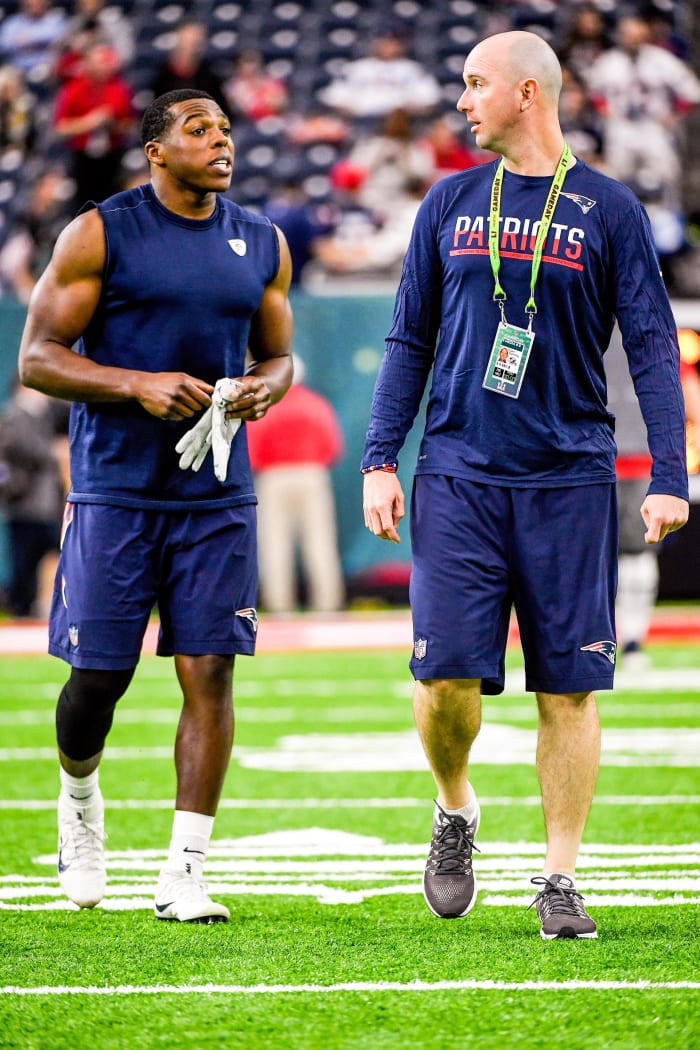
Easterby with defensive back Jordan Richards before the Patriots' victory in Super Bowl LI.
Jim Mahoney/AP
For dozens of players, Easterby became an essential part of their lives. After the Patriots took Derek Rivers in the third round of the 2017 NFL draft, Easterby greeted the defensive end at team headquarters with a bear hug. Rivers called his mother after their initial meetings. “You gotta meet Jack Easterby,” he gushed. Eventually, Easterby performed the wedding ceremony for Rivers and his then girlfriend, Lauren—twice. The first was small, done quickly, Easterby told Rivers, so that he could concentrate on football in his rookie season and still live with his wife, and then later a larger ceremony in the offseason. One year, Easterby invited Rivers, offensive coordinator Josh McDaniels and their families to celebrate Easter at his home, complete with an egg hunt and a Wiffle ball contest.
Many who worked for or with the Patriots during Easterby’s tenure there saw him as something of a cheerleader, and they don’t mean that in a negative sense. Easterby was all hugs, high-fives and fist bumps. Three sources from that time in New England agree that Belichick approved of these sideline theatrics; if he hadn’t, all reasoned, they would not have taken place. “He was magnetic, and the energy in New England is the opposite of that,” says one person who saw the sideline dynamic up close. “All you need to do [to be a counter to Belichick] is exhibit a little bit of EQ, and Jack has a lot. People were attracted to that.”
Supporters and detractors say the same thing: Easterby has been able to accumulate power throughout his career because of his ability to build and strengthen relationships. In Foxboro, he was simultaneously a conduit between the players who trusted him and the coaches who wanted to better understand their players’ emotional needs. He managed a rare duality: He was sought out by most of the Patriots’ locker room and by Belichick.
* * *
It was an increasingly common sight in 2019. McNair, in his first full season as the franchise’s principal owner, would watch over practice 50 yards away. Next to him was Easterby, his newest hire and a man with whom he shared a deep religious faith. Often, no other member of the franchise was within earshot as the two chatted. Some saw this as the perfect visual to explain Easterby’s changing role in his first year: farther away from the players and closer to the owner.
While Easterby did forge some connections, four people who worked for the Texans around this time say that he did not have a relationship with Hopkins, one of the team’s most important players. Hopkins had earned first-team All-Pro honors in each of the three seasons since Houston drafted Watson in 2017. The emerging quarterback and star receiver led Houston to back-to-back division titles in ’18 and ’19. They also shared a close bond that extended beyond their prolific relationship on the field; the players jointly held a Thanksgiving dinner for teammates and members of the organization who didn’t have family in town for the holiday.
O’Brien, who assumed the GM title nine months before being fired, took the brunt of the backlash for Hopkins’s unpopular trade, which has proved to be lopsided. While O’Brien negotiated the terms—the consensus was that the coach wanted to trade Hopkins as well—the same sources who recounted Easterby’s perceived coldness to Hopkins say it went further: They describe Easterby as the first, and most persistent, advocate for the team’s trading the receiver out of Houston. One of these people recalls hearing Easterby saying about Hopkins in front of small groups of people on multiple occasions in 2019, “We need to move on from that person,” without using his name. Another recalls learning that the Texans discussed trading Hopkins as early as the summer of 2019.
Hopkins’s trade left a void in the Texans’ offense and in the locker room. The receiver often led a call and response when breaking down meetings, calling out “Glory!” to which his teammates would respond “Hallelujah!” Watson carried on that tradition this season as a nod to his former teammate, and Hopkins agreed to a two-year extension with the Cardinals. (Hopkins is No. 2 in the NFL with 85 catches.)
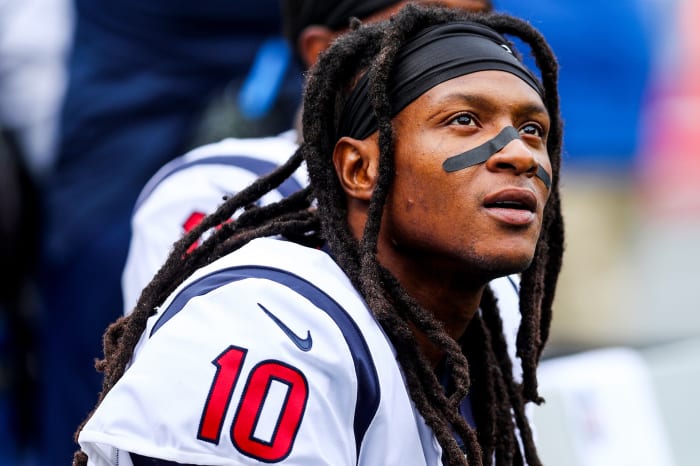
Hopkins was first-team All-Pro in each of his last three seasons in Houston.
Maddie Meyer/Getty Images
Some of Easterby’s staples weren’t as effective in Houston as they had been at previous stops. Those motivational cards from his South Carolina days traveled to New England, and then to Houston, where they were customized with the Texans’ logo. Each week, a new card would appear on players’ stools in the locker room and on employees’ desks. Members of the organization asked one another if they could throw the cards away without repercussions—at least one did. Eventually word reached Easterby: This particular tool had not resonated.
Easterby also began occasionally addressing the team on the nights preceding games, turning the meeting room into his pulpit. But some of his efforts to relate to the majority-Black roster occasionally failed him; in some cases he even caused offense. During one Saturday-night meeting in 2019, Easterby, who is white and cites Martin Luther King Jr. as a role model, asked players to think back to when they were growing up “playing ball with Ray-Ray and Ki-Ki and them,” according to three people in the room for these meetings. Some saw the language as more of a misguided attempt to fit in—players often called Easterby a “try-hard.” But at least one person was bothered enough by what they saw as a use of Black stereotypes that they debated saying something to Easterby. (They decided not to take on that conversation with a game the next day.) A few weeks later, one of the sources says, Easterby used similar language again.
A culture of distrust had started to permeate the organization. Multiple Texans from Easterby’s tenure say they began to watch what they would say in conversations with him, nervous that the culture coach was looking for reasons to move out people with different values or lifestyles. Those worries weren’t limited to the workplace. One player was so convinced he was being followed by someone representing the team that he paid a friend to watch the dark sedan he says he observed frequently parked outside his house. He even went so far as to log license plate numbers of unfamiliar cars. Two other members of the organization shared the player’s concerns that members of the team were being surveilled away from the building. (The Texans did not respond to specific questions about these accounts.)
* * *
Have a tip? Email us.
* * *
The image of Easterby emerging in Houston doesn’t square with his caricature in New England, where he became close with someone who doesn’t become close with many: Belichick. In Foxboro, Easterby had ascended quickly, though the responsibility he added wasn’t necessarily sent out in press releases. After Year 1, he told one friend, the equipment staff began to report to him. Year 2: the training camp staff. Year 3: football operations.
A former colleague describes this hypothetical ascension as grounded in fact, but also embellished. The Patriots have little additional training camp staff, for instance. It’s clear that Easterby did amass more responsibility—and that he did it through Belichick. Two employees who worked with Easterby say that he could speak to the Patriots’ coach in an honest way, more truthful than, say, an assistant might. It was part of the character coach’s job to say tough things, to share deep secrets and concerns. “He became a trusted confidant for Bill,” Easterby’s friend says. (Belichick, through the Patriots, declined to comment on this characterization.)
Even then, some in the building had started to suspect Easterby’s motivations. One person who saw his sideline histrionics up close says they were more show than substance: “When you see him and the big personality and how he's moved up the ladder so fast, you’re like, ‘Man, this isn't authentic. Something doesn't feel genuine about this.’ ” Others saw him sidling up to assistants. They noticed that he hired an agent who represented coaches and executives, an unheard-of move for a chaplain in pro sports. One Patriots staffer compared Easterby to a preacher at a megachurch—a man of God who stands onstage and denounces the ills of poverty, then slips out the backdoor, into a private jet. Several current and former colleagues, from Foxboro and Houston, agree that this description is accurate.
Easterby told people that Kraft, New England’s owner, had offered him and Caserio, the longtime personnel czar, “lifetime” contracts to run personnel. But Easterby intimated that he had turned down that offer, lest it look like he was going behind Belichick’s back. (The Patriots, through a team spokesperson, say such a contract was never offered.)
Belichick’s tacit approval opened doors, and Easterby was eager for an expanded role from the one he had in Foxboro. In 2018, Easterby visited Carolina, where he met with new Panthers owner David Tepper and others. He drew interest from Miami, where a former Patriots assistant, Brian Flores, had been hired as the coach. Many believed Easterby would leave for Indianapolis with Josh McDaniels, but the coach backed out of an offer he accepted with the Colts. At that point, Easterby had an expiring contract and no immediate new offers.
Then the opportunity arose in Houston—an organization with a novice owner, a new general manager and a power vacuum waiting to be filled. As Easterby’s responsibilities grew, he discouraged communication between departments that previously talked often. According to two team employees, he made it so that many actions that previously did not need approval required his sign-off. The man who had once been known for cheering on the sidelines during games was now serious, taking notes on a piece of cardstock. He decreed that team employees couldn’t wear sunglasses during games unless they were playing outdoors and there was discernible sun. He wanted to look them in the eyes.
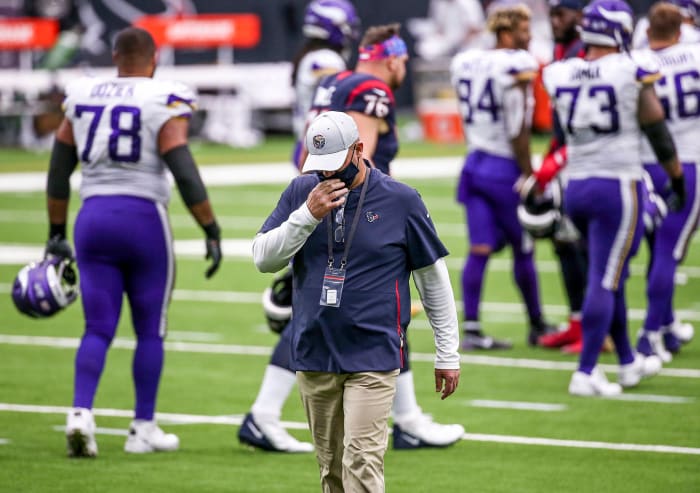
The loss in Minnesota, dropping the Texans to 0-4, would be O'Brien's last game as the Texans head coach.
Troy Taormina/USA TODAY Sports
The partnership between Easterby and O’Brien appeared to work well at first. O’Brien wasn’t at odds with Easterby the way he had been with former GM Rick Smith, and Easterby took on tasks that gave O’Brien more time for his priority—coaching. But as Easterby continued to expand his influence in 2019 and beyond, team employees began to wonder when O’Brien would finally see Easterby the way they did. By that point, three Texans say they believed that the vast majority of the franchise did not trust the person brought in to improve the culture. Two of them estimate that 85% of the building did not trust Easterby; another upped the percentage to 90.
Even in an industry known for high turnover, many of the changes made during Easterby’s tenure sent shockwaves through the organization. J.J. Moses, a well-liked former player serving as the team’s player engagement director, was dismissed after the 2019 season, along with several other staff members. Amy Palcic, who led an award-winning p.r. staff, was fired midseason for not being a “culture fit”; the move raised more questions than answers about the kind of culture the team was trying to build. (Both Moses and Palcic declined to comment. As part of a statement provided to SI by a team spokesperson on McNair’s behalf, the owner said, “I am the one that made the decision to part ways with our GM and head coach. … I will not get into specifics about any decisions made regarding former employees of the Texans other than to say that I was aware of and approved every decision, and I hold the responsibility and accountability for each one.”)
In the meantime, with O’Brien as GM and Easterby’s influence growing, Houston began making additions with Easterby’s fingerprints on them, on and off the field. After dealing Hopkins, the Texans turned around and acquired Brandin Cooks, a speedy but injury-prone receiver who was close to Easterby when they were both in New England, parting with a second-round pick. It was a clear overpay, even before factoring in the disappointing return they got for Hopkins (a second-round pick and running back David Johnson). One new addition that staffers noticed: The team awarded an internship to a former South Carolina golfer who had gone to the same high school as Easterby; among his duties, this intern would set up in the home team’s tunnel and spin records, to the annoyance of the football team trying to get onto the field.
Just like Gaine had been isolated and fired, just like Hopkins had been traded, just like the roster had been made over, another domino would fall. Nine months removed from a close playoff loss to the eventual Super Bowl champion Chiefs, as the Texans worked their way to an 0–4 start, one player was approached by Easterby. The executive had foreshadowed a coaching change, the player told a person close to him, and asked for the player’s support when it happened. The day after a loss to the Vikings, Easterby wandered aimlessly around the office in a way that struck others as unusual, while telling colleagues that he had spoken to McNair after the defeat. Several hours later, O’Brien was fired (O’Brien, through his agent, declined multiple requests for comment).
* * *
Over the years, from Kansas City to Foxboro to Texas, Easterby and his wife, Holly, stayed in touch with many of the people he’d mentored at South Carolina. The couple offered life counseling and helped many get started in careers in and out of sports; Jack presided over several weddings. SI reached out to more than a dozen of Easterby’s connections from Columbia, and along with glowing reviews, many—unprompted and in strikingly similar language—concluded conversations by admonishing the media in general for stories about Easterby that were “untrue,” encouraging SI to present the truth.
With his growing profile came growing scrutiny over Easterby’s past. In October, Pro Football Talk’s Mike Florio, a persistent critic, wrote about discrepancies in Easterby’s public résumé. At the time, a Texans spokesperson dismissed the piece, explaining that there was a “meaningless oversight in a bio from an entry-level position in Jacksonville 16 years ago. ... His employment paperwork was accurate with the correct description of his internship.”
At least partially fueling the controversy is the lack of definition for Easterby’s job during Jacksonville’s 2004 training camp. He landed an internship thanks to a connection with Steven Drummond, a South Carolina alum and now the Panthers’ VP of communications and external affairs, who was working in the Jaguars’ PR department at the time. The two met through Young Life, the religious mentoring organization, when Easterby was in 10th grade.
Easterby roamed that summer, interacting with players in the locker room and stopping by offices in different departments—p.r., salary cap management, football operations. “He didn’t stick to whatever job he had,” says one ex-Jaguars staffer who didn’t take issue with the roaming. “He was all over the building, trying to do other people’s jobs.” (The Jaguars declined comment when asked to provide clarity on Easterby’s role.)
In media reports, Easterby has said that during that time he was “in the ticket office,” or “in football operations to work with the salary cap,” or that he worked “mainly on salary cap matters” or “in salary cap administration.” Meanwhile, starting with his arrival as South Carolina’s character coach, his public-facing bio morphed.
- In the men’s basketball team’s 2008–09 and ’09–10 media guides, his job in Jacksonville was described as “an assistant to the director of operations.”
- In his next appearance, as the Patriots’ team chaplain for the ’15 season, “an” had become “the,” and—in a Dwight Schrute–ian twist straight out of The Office—“to the” had been dropped: “the assistant director of operations.”
- In the ’16 Patriots guide, after he officially took on the title of “character coach/team development,” the Jaguars gig became “the assistant director of football operations.”
The idea of a 21-year-old serving as “the assistant director of football operations” for one of the NFL’s 32 franchises is incredible, bordering on fantastical. And yet that specific language lasted all the way to the Texans’ 2019 media guide. The Patriots explained that all media guide bios are provided to each player and staff member individually for approval and have emails confirming receipt and approval from Easterby in 2015 and ’16.
The Texans did not respond to specific questions about their editing process. Easterby’s bio was heavily revised for the ’20 media guide—and updated online—to state that he “gained his first NFL experience in the summer of ’04 with the Jacksonville Jaguars, helping in football operations and public relations.” In a statement provided to SI by a Texans spokesperson, McNair said that Easterby’s background was “fully vetted” and that the owner stands by his hiring.
As recently as November, a bio for Easterby that appeared on the website for the Greatest Champion Foundation (a nonprofit with a goal of serving athletes holistically through faith and founded by Easterby and his father) claimed that Easterby has over the years “been entrusted with over 50 head coaching searches at both power-five and mid-major universities for multiple sports.” Neither the Texans nor Easterby addressed specific questions from SI about which programs he has worked with on coaching searches and in what capacity.
That foundation’s site was down for most of the past month—a staffer explained that it was due to a redesign and migration to a new content management system—and when the new version launched last weekend, Easterby no longer had a bio. He is still noted as the foundation’s founder and chair of the board of directors, and the foundation’s latest 990 tax return says Easterby worked there an average of 40 hours per week in 2019, also his first year in Houston, collecting a salary of $16,981. A statement provided to SI by a Texans spokesperson on Easterby’s behalf reads, in part, “I have made no false claims about my experience, nor my work with my Foundation.”
Considering his limited experience in pro football, these shifting credentials can be seen as an attempt to retroactively justify the roles he held in the NFL—particularly his current one, for which many feel he is unqualified. Perhaps more off-putting: A leader, whose greatest skill is his ability to build strong moral character, long maintained a public bio that may not have been fully transparent about his past.
* * *
Like Littlefinger became Lord Baelish, Easterby ascended to the top of the Texans’ hierarchy, his power consolidated and widespread. Not that long ago, some NFL insiders wondered whether he might become the Texans’ next (not interim) GM. But the lofty perch presented another, related problem: not how to get there, but how to stay. Instead, Easterby took control of his football kingdom only temporarily, and soon, it seems, it will be ruled by someone else.
The Texans sent that message again Tuesday. One day after SI provided the Texans with a list of questions regarding the details of this story but before its deadline for the team’s response, McNair sent a letter to season-ticket holders announcing the Texans had assembled a star-studded committee to conduct the search for the Texans’ next coach and general manager. Hall of Fame coaches Tony Dungy and Jimmy Johnson, as well as franchise legend Andre Johnson and others, will join McNair, team president Jamey Rootes and search firm Korn Ferry in the process.
In a statement provided to SI by a Texans spokesperson, McNair said he believes Easterby did “a great job picking up [GM] responsibilities in addition to his other duties,” but that he wants to “make it clear that Jack is not on our internal search committee for the next GM or head coach. ... However, I value Jack’s input and if he has firsthand knowledge about a specific candidate, I will ask for his observations and feedback.” He and the next GM, McNair affirmed, will determine the roles of all football operations employees, including Easterby.
There’s a sense that Easterby is scrambling. Confidants say that the last couple of months have been a tough time for Easterby, as he’s faced what McNair labeled as “personal attacks.” He’s trying to hang on as the roles he once captured slip away. Those who were with him in that first season in Houston know that he’s capable of doing it. As one former Texans staffer says, it doesn’t matter what the rest of the building thinks of him. “All you have to do is convince one or two people, then isolate them from the thoughts and feelings of the rest of the staff.”
Last November, the Texans boarded their team charter for a 10-hour trip home after a game against the Jaguars in London. Mid-flight, several players gathered around a table in the galley area, playing cards and sharing laughs after their sixth win of the season. Nearby, Easterby knelt in an aisle, speaking in a low voice to McNair. The volume of the card game grew, and Easterby took his stand. He rose and made a move toward the galley, shushing the players, demanding quiet—imploring them that Mr. McNair needs his sleep. Then he returned to his post, by the owner’s side, the one voice in his ear.




































